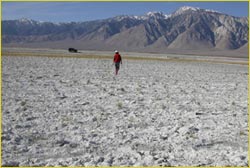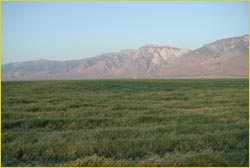 |
The
Owens Lake project is an example of Nakae's capabilities
in a large saltgrass planting project. Owens Lake was a
prehistoric freshwater lake that had dried up due to diversion
of its water in 1913 to supply the city of Los Angeles.
By 1926 the lake, now completely dry, had become the largest
source of dust pollution in the United States, violating
the EPA standards by as much as 23 times greater than the
federal standards allow. In 1998 the County of Los Angeles
and the Great Basin Air Pollution Control District agreed
to undertake the project of bringing the region up to federal
air pollution standards by 2006. Thirteen and a half square
miles of the lake were shallow flooded and, due to extremely
harsh salty conditions, salt grass was plugged in 2,240
acres, 400 of which did not establish themselves due to
extreme conditions.
Nakae
and Associates, Inc. was retained to propagate and plant these 400 acres with
1,500,000 salt grass plugs. A special priming method and temperature variations
during germination were developed by the project biologist with a resulting 85%
germination rate. Conventional equipment could not be used to distribute plant
material for fear of damaging existing plants so special equipment was designed
for the project enabling Nakae to achieve an 85% establishment rate, a very successful
outcome under extremely harsh conditions. Constant monitoring of every aspect
of the project was necessary to meet growth requirements. | click
images to view larger
 
|